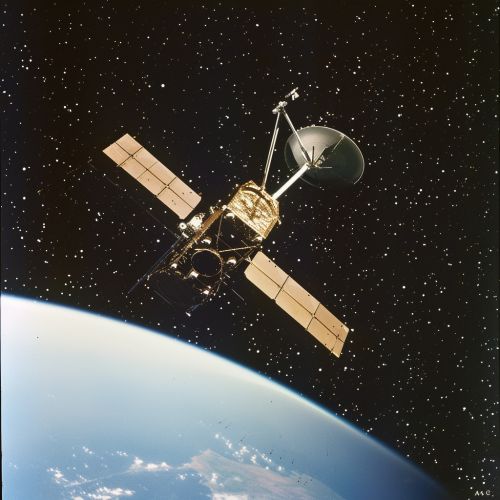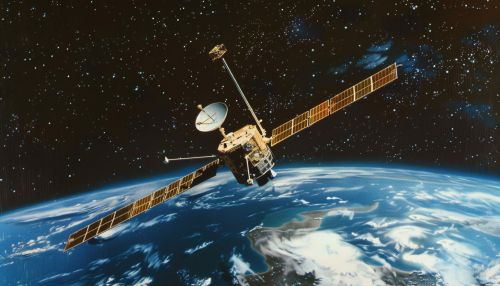Telstar 1: Difference between revisions
(Created page with "== Introduction == <div class='only_on_desktop image-preview'><div class='image-preview-loader'></div></div><div class='only_on_mobile image-preview'><div class='image-preview-loader'></div></div> Telstar 1 was the first active, direct relay communications satellite. It was launched on July 10, 1962, by NASA and was a collaboration between AT&T, Bell Telephone Laboratories, NASA, the British General Post Office, and the French National PTT (Post, Telegraph, and Telecom...") |
No edit summary |
||
| Line 1: | Line 1: | ||
== Introduction == | == Introduction == | ||
[[Image:Detail-92453.jpg|thumb|center|Telstar 1 satellite in space|class=only_on_mobile]] | |||
[[Image:Detail-92454.jpg|thumb|center|Telstar 1 satellite in space|class=only_on_desktop]] | |||
Telstar 1 was the first active, direct relay communications satellite. It was launched on July 10, 1962, by NASA and was a collaboration between AT&T, Bell Telephone Laboratories, NASA, the British General Post Office, and the French National PTT (Post, Telegraph, and Telecommunications). The satellite marked a significant milestone in telecommunications history, enabling the first live transatlantic television feed and ushering in a new era of global communications. | Telstar 1 was the first active, direct relay communications satellite. It was launched on July 10, 1962, by NASA and was a collaboration between AT&T, Bell Telephone Laboratories, NASA, the British General Post Office, and the French National PTT (Post, Telegraph, and Telecommunications). The satellite marked a significant milestone in telecommunications history, enabling the first live transatlantic television feed and ushering in a new era of global communications. | ||
Latest revision as of 11:51, 14 June 2024
Introduction


Telstar 1 was the first active, direct relay communications satellite. It was launched on July 10, 1962, by NASA and was a collaboration between AT&T, Bell Telephone Laboratories, NASA, the British General Post Office, and the French National PTT (Post, Telegraph, and Telecommunications). The satellite marked a significant milestone in telecommunications history, enabling the first live transatlantic television feed and ushering in a new era of global communications.
Development and Design
Telstar 1 was developed as part of a larger project to explore the feasibility of satellite communications. The satellite was designed and built by Bell Telephone Laboratories. It was a cylindrical satellite, measuring about 34.5 inches in diameter and weighing approximately 77 kilograms. The satellite was equipped with a variety of advanced technologies for its time, including transponders, solar panels, and a sophisticated telemetry system.
The satellite's transponders were designed to receive signals from Earth, amplify them, and then retransmit them back to Earth. This allowed for real-time communication across vast distances. The solar panels were used to generate power for the satellite's systems, while the telemetry system provided data on the satellite's status and performance.
Launch and Initial Operations
Telstar 1 was launched atop a Thor-Delta rocket from Cape Canaveral, Florida. The launch was successful, and the satellite was placed into a highly elliptical orbit with an apogee of about 5,643 miles and a perigee of about 593 miles. This orbit allowed the satellite to cover a large portion of the Earth's surface, making it ideal for transatlantic communications.
Shortly after reaching orbit, Telstar 1 began its mission. The first test transmissions were conducted on July 11, 1962, and included a variety of signals, such as television images, telephone calls, and data transmissions. These tests demonstrated the satellite's capabilities and paved the way for more extensive use.
First Transatlantic Television Broadcast
One of the most significant achievements of Telstar 1 was the first live transatlantic television broadcast. On July 23, 1962, Telstar 1 successfully relayed a television signal from Andover Earth Station in Maine, USA, to Pleumeur-Bodou, France. The broadcast included images of the American flag, a baseball game, and a press conference by President John F. Kennedy. This event was a major milestone in the history of television and telecommunications, showcasing the potential of satellite communications.
Technical Specifications
Telstar 1 was equipped with a variety of advanced technologies for its time. The satellite's transponders operated in the microwave frequency range, specifically at 6 GHz for uplink and 4 GHz for downlink. This allowed for high-quality signal transmission with minimal interference.
The satellite's power system was based on solar panels, which generated electricity from sunlight. These panels were capable of producing about 14 watts of power, which was sufficient to operate the satellite's systems. The satellite also had a battery system to provide power during periods when it was not in direct sunlight.
The telemetry system on Telstar 1 was used to monitor the satellite's status and performance. This system transmitted data on various parameters, such as temperature, power levels, and signal strength, back to Earth. This information was crucial for ensuring the satellite's proper operation and for diagnosing any issues that arose.
Impact on Telecommunications
Telstar 1 had a profound impact on the field of telecommunications. The successful demonstration of satellite communications paved the way for the development of more advanced communications satellites. This led to the establishment of global communications networks that are still in use today.
The success of Telstar 1 also spurred further research and development in the field of satellite communications. This included the development of more advanced satellites with greater capabilities, as well as the establishment of international standards for satellite communications.
Challenges and Issues
Despite its successes, Telstar 1 faced several challenges and issues during its mission. One of the primary challenges was the satellite's limited power supply. The solar panels were only capable of generating a small amount of power, which limited the satellite's operational capabilities.
Another issue was the satellite's orbit. The highly elliptical orbit meant that the satellite was only in a position to relay signals for a limited portion of its orbit. This required careful planning and coordination to ensure that communications were successful.
Additionally, Telstar 1 experienced technical issues during its mission. One of the most significant issues was the degradation of its transponders due to radiation exposure. This ultimately led to the satellite's premature failure in February 1963, after only seven months of operation.
Legacy
Despite its relatively short operational life, Telstar 1 left a lasting legacy. The satellite's successful demonstration of satellite communications paved the way for the development of more advanced communications satellites. This led to the establishment of global communications networks that are still in use today.
Telstar 1 also had a significant impact on popular culture. The satellite's name became synonymous with the dawn of the space age and the potential of satellite communications. The success of Telstar 1 inspired further research and development in the field of satellite communications, leading to the creation of more advanced and capable satellites.
